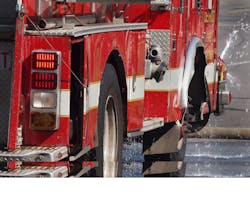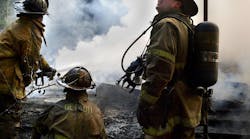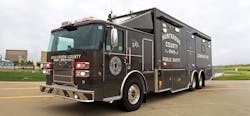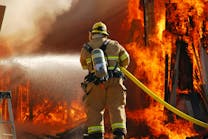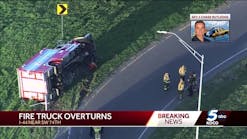As the Detroit engine pulled in the alley, they found the almost-new Cadillac DeVille fully involved. The license plates were torn off indicating the car might be stolen. While the fire was being extinguished, the officer found the owner’s handicapped tag lying on the ground. He radioed Central to give them the information, and they said they didn’t want it. There was little chance that the police, facing budget cuts the same as the fire department, would respond. The owner would remain unidentified and the car may not be removed for a year or more.
Welcome to Detroit.
I visited there last weekend and talked to some of the firefighters on the front lines. Morale remains high but the future looks bleak. There’s just not enough money to keep it running as it should.
The administration is about to lay off 160 firefighters, but will hire some back when the funds from a recently-awarded SAFER grant come through. Demotions will affect 193 in all ranks from Battalion Chiefs to pump operators. The repair shops are having trouble making ends meet—minor repairs are often deferred until the unit breaks down on the street. This week, an average of 21 fire companies were out of service each day, almost 1/3 of the city’s front line units.
The combat troops have lost faith in the administration’s ability to provide the leadership need to cope with the escalating deterioration of the department. The budget cuts came about when the Mayor and City Council were late in filing a budget with the state under a consent decree, designed to head off having the state come in and take over the city administration. Instead of moving funds around and selectively eliminating non-essential services, they simply hacked a fixed percentage off each department’s budget—a simple way of pleasing the state, but the result is having disastrous effects on delivery of fire, EMS and police services.
At a public meeting last Tuesday, Fire Commissioner Don Austin said, “I’m doing the very best I can do.”
A few days before, a 15-year old boy who was shot died after being transported to the hospital in a police car. A fire department ambulance was not available.
The breakdown of the fire department infrastructure is coupled with the fact thatDetroitis the undisputed arson capitol of the country. But, there are only eight arson investigators in a city that averages 8 to 10 arson fires a day. Where do they begin?
Commissioner Austin continued explaining at the town meeting. “If we go over budget, that trigger with the cocked gun called emergency manager is waiting for us.”
That means that if the city administration cannot manage the city and its finances, the state will come in and appoint an emergency manager to take it over. More than one observer remarked that of course if that happens, then the administration from the Mayor to the City Council members down to appointed positions that include the Fire Commissioner might lose their jobs. The city administration is running scared, and public safety is suffering because of it.
You might think that laboring under such an administration would make firefighters and officers a bit cranky, and yes, that is a fact. On the other hand, they are the constant in this crisis—still reporting every morning and doing their jobs but, asking for a little help.
Pne officer told me that they are rotating the companies they are taking out of service, and then not informing the shift working, what companies are closed. An oncoming shift officer has to make a number of calls to neighboring companies and to the union to determine how big on an area they might have to cover for the day and if their first arriving ladder company is closed. That’s nonsense.
You’ll remember that there was quite a bit of yelling and screaming and gnashing of teeth in the nation’s fire service when the Commissioner announced a few months ago that they are going to have to let some vacant buildings burn.
“That’s not exactly true,” an officer explained to me. If the building is fully involved, or “going throughout” in Detroit jargon, (and most of the vacants are in that condition on arrival of the first company) of course it cannot be searched until the fire is knocked down. If the building is deemed not stable, such as having a collapsed roof, staircases or floors, no entry will be made and the fire handled from the outside. If a vacant building has only one or two rooms going, they will make entry for knock-down and search.
The death of Detroit firefighter Walt Harris in 2008 while overhauling after a fire in a vacant building, made the department more aware of being more practical in accessing risks while sizing up fires in vacant properties. Because of that death, there is now a RIT company assigned to box alarms, and that company’s officer is the fireground safety officer, keeping an eye on hazards and helping keep firefighters out of harm’s way.
There are around 78,000 vacant structures littered across the city — almost every block has one. If they burn at the average rate of 10 a day, that calculates out to 1,114 weeks of fire, about 21 years worth. That is, if no other buildings are abandoned in the meantime.
One would assume that most arson fires happen at night, but not inDetroit. When I was there, I took in two arson fires, one at 8:30 and one at 9:13, both in vacant buildings. Now who in their right mind would torch a vacant building early in the morning on a bright sunny day? Welcome toDetroit, the 24-hour, city on fire.
I noticed greater use of 2-1/2” lines on the initial attack, something that was rare a few years ago, and it is now common for the second engine to “dump its gun” on the fire before dropping its lines and stretching to a hydrant. If a building is isolated, the strategy is to simply confine it and let it burn down to a level where it can be extinguished by and aerial stream and a couple of ground hand lines.
Chiefs are careful about calling in extra help. They will do so quickly if needed, but are always aware that those companies may be needed elsewhere.
With the frequency of working fires, and the budget cuts taking companies out of service, the department is beginning to suffer from a lack of depth. For example, a serious high-rise fire downtown could easily put 10 or more companies to work. Then, a couple of vacant building fires could take out 10 more, leaving the city woefully uncovered.
The situation of fewer companies responding to an increasing amount of fires is starting to beat up the troops. And, keep in mind thatDetroitis one of the few cities where suppression companies do not respond to medical calls. If they did, there would be even fewer suppression units available to respond to fire calls.
It looks like it is going to get worse before it gets better. The increased workload is going to take an ever increasing toll on both the members and apparatus, and budget wise, right now, with the present administration, there is no light at the end of the tunnel.
It seems the Motor City firefighting machine is driving down the street on two flat tires -- it’ll try to get there but it’s going to take some time.
Fox 2 reporter Charlie LeDuff has covered the Detroit Fire Department crisis with accuracy and passion.
Take a look at this report http://www.myfoxdetroit.com/story/19005453/charlie-leduff-50-less-fire-engines-on-streets-in-1-month
If you would like a quick overview of what the Detroitis like today, follow this link to see LeDuff golfing across the city: http://www.myfoxdetroit.com/video?clipId=7465460&autostart=true
View the Detroit: City on Fire Photo Gallery here.
